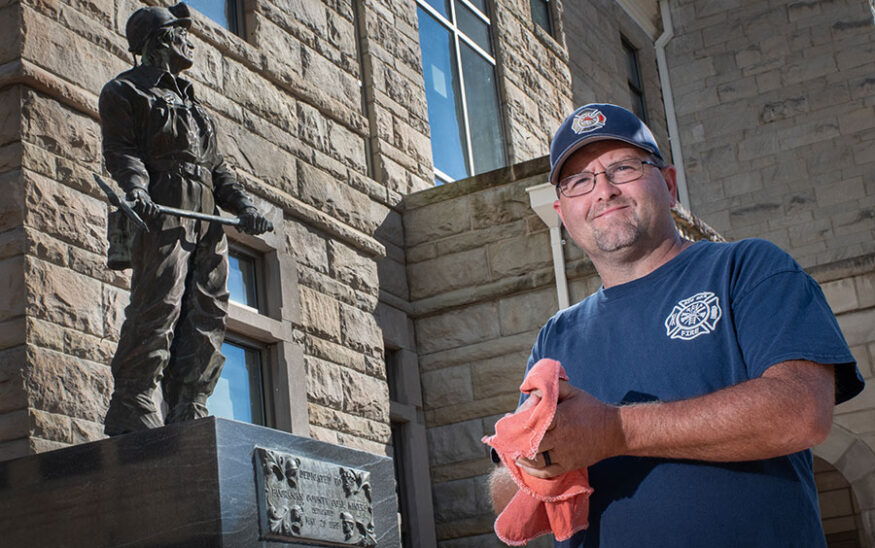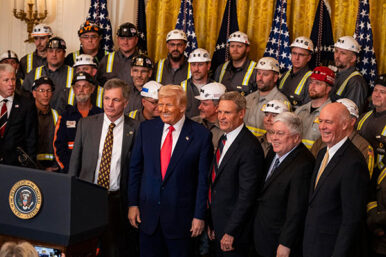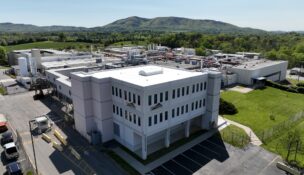Despite federal coal support, Southwest Virginia aims to diversify

Mikey Elswick was a fourth-generation coal miner before he switched careers amid the industry’s decline. A volunteer firefighter, he now runs T&W Pest Control. Photo by Tim C. Cox

Mikey Elswick was a fourth-generation coal miner before he switched careers amid the industry’s decline. A volunteer firefighter, he now runs T&W Pest Control. Photo by Tim C. Cox
Despite federal coal support, Southwest Virginia aims to diversify
Summary
- U.S. and Virginia coal production continue to fall; metallurgical coal remains a valuable but limited market.
- State and federal programs (AMLER, grants, proposed federal support) fund redevelopment and energy projects.
- Region eyes data centers, SMRs (small modular reactors) and clean-energy projects tied to transmission upgrades.
Mining was a family business for Mikey Elswick. His great-grandfathers, grandfather, father and uncle worked in the mines, and in his early 20s, Elswick went to work there, too, as a blaster, helping remove rock from the surface to gain access to the coal below.
Elswick, who lives in Buchanan County’s Big Rock area, enjoyed the work. With licenses in Virginia, Kentucky and West Virginia, he traveled throughout the region, eventually making about $27 an hour.
“It was great pay,” Elswick says. “It was good when it was good, but when it went bad, I mean, you didn’t know from week to week if you was going to get laid off and not have a job next week or not.”
Though Elswick never got laid off, the writing was on the wall. During his 15 years in the coal industry, he worked for three different companies. A decade ago, when his last employer, TECO Coal, in Hurley, announced it was going to sell to a Kentucky-based firm that planned to slash his pay by $4 an hour as well as his insurance benefits, he jumped at an opportunity to buy a pest control company, T&W Pest Control, that had been owned and operated by a previous coal miner.
The move was Elswick’s way of finding stability. He’s also been able to stay near family in Buchanan, where he continues to witness the effects of a volatile industry that has been in decline for decades, not just in Southwest Virginia but nationwide. A brother-in-law was among 72 workers laid off this year by Wellmore Energy Co., a metallurgical coal mining company and subsidiary of Tennessee-based United Coal, across several mining operations in Buchanan, Elswick says. And while his brother-in-law found work at another mining operation, others may face a hard time.
“Ten years ago, you could go to another company and get a job fairly easy,” Elswick says. “Now, there’s just not that many companies still left around here. If you do get laid off, it’s a little harder now to just run down the road and … get another job with another company.”

Coal’s decline
In April, flanked by coal and energy workers wearing hard hats, President Donald Trump signed multiple executive orders aimed at reviving “beautiful clean coal.” Those orders allowed some coal-fired facilities that were scheduled for retirement to continue to make electricity, granted a two-year extension on federal regulations that would have reduced emissions from some toxins and also lifted barriers to coal mining on federal land.
The Trump administration followed up on that in late September, saying the federal government would open 13 million acres of federal lands for coal mining and provide $625 million to recommission or modernize coal-fired power plants. The moves come as Trump has vowed to reverse the years-long decline in the U.S. coal industry.
Coal is a reliable but polluting energy source that’s long been shrinking amid environmental regulations and competition from cheaper natural gas. Under Trump’s orders, the Energy Department has required fossil-fueled power plants in Michigan and Pennsylvania to keep operating past their retirement dates to meet rising U.S. power demand amid growth in data centers, artificial intelligence and electric cars.
The Trump administration’s support for the coal industry has been received positively in the Southwest region, says Jonathan Belcher, executive director and general counsel of the Virginia Coalfield Economy Development Authority, which was established in 1988 by the state General Assembly to help diversify the region’s economy.
“They will help to ease some of the economic burden on the coal industry and hopefully help it to remain stable and continue for at least a few more years to come there,” Belcher says. “There’s still reserves of coal that are mineable in Virginia. … The question is, though, can it be done in an economical fashion, where the companies can still stay in business and make a profit?”
Coal was once king in Southwest Virginia, and the industry remains hugely important to the regional economically, with about a 9.9% total economic impact, according to an April report on the coal and natural gas industries prepared for VCEDA. Also, according to the report, the average coal industry salary in the region was $101,268 in 2024, more than twice the region’s annual salary of $45,926. But the industry has also felt the constraints of competition from other energy sources as well as environmental regulations and other factors.
U.S. coal production was at 578 million short tons in 2023, down from just over a million tons in 2014, according to the U.S. Energy Information Administration (EIA), which forecasts that production will continue to decline from 512 million short tons in 2024 to 483 million short tons in 2025.
Virginia’s coal mines produced 10 million short tons of coal in 2023, a figure that declined to 8.6 million short tons in 2024, according to the VCEDA report. Metallurgical, or “met” coal, which is used in the manufacturing of steel and for other uses, accounts for about 80% of coal mined in Virginia, according to the Virginia Department of Energy, and had an estimated market value of $1.7 billion in 2024.
Meanwhile, in 2023, according to EIA, just 2% of Virginia’s in-state electricity generation was coal-fueled, while natural gas accounted for 55%, nuclear power provided 32% and renewables (largely solar and biomass) contributed 12%. Virginia has two coal-fired energy production plants: Dominion Energy’s Clover Power Station in Halifax County and Virginia City Hybrid Energy Center, also owned by Dominion, in Wise County. Each are allowed to operate until 2045.
While Trump’s executive orders may have a stabilizing effect on Virginia’s coal industry, they have had no noticeable effect so far, according to multiple observers, as well as the Virginia Department of Energy.
Michael Quillen, a former coal executive who once led Abingdon-based Alpha Natural Resources — now Bristol, Tennessee-based Alpha Metallurgical Resources — chairs the Southwest Virginia Energy Research and Development Authority, which was created by the state to develop energy jobs in the region. Coal energy production has increased about 6% nationally and mostly in states like Illinois and Wyoming, and he attributes that to economics, not Trump’s orders.
“It really goes back to the fundamentals that the natural gas price is up,” Quillen says. “So, when a power plant has the opportunity to either dispatch coal or dispatch natural gas, it’s going to go with whichever one’s the most economic.”
With such little energy in Virginia now produced by coal, any real boosts are more likely to be seen in the more lucrative met coal industry. And, while most met coal produced in Southwest Virginia is currently exported, with demand for steel rising amid Trump’s tariffs, his promises to bring back American manufacturing, and renewed emphasis on U.S. Navy shipbuilding, Virginia Department of Energy Director Glenn Davis says the state’s coal industry could benefit.
“I think the trend line … is leaning towards a significant increase in domestic steel production and usage, which inherently leads to an increase in the necessity of further or increased met coal production,” Davis says.
Going nuclear
In 1990, the coal industry represented 13.2% of the region’s workforce, employing a little less than 12,000 people. By 2024, the industry employed about 2,500 workers, representing just 2.4% of the region’s workforce, according to the VCEDA report.
Coal’s decline has left its scars on Southwest Virginia, which has seen its young adult population dwindle, according to a June report by the University of Virginia’s Weldon Cooper Center for Public Service. The region is on track to lose about 100,000 people by 2025.
Regional workforce and economic development leaders are aware of this statistic and have been working to diversify the economy for decades. With power demand in the U.S. expected to double or triple by 2028 — a demand that could triple in Virginia as data centers continue to spread — some leaders see an opportunity to harness Southwest Virginia’s legacy to reclaim its spot as an energy juggernaut.
“Every amount of energy you can produce, going forward … for the foreseeable future … is going to be infinitely valuable. By doing energy in this region, you’re creating a valuable commodity that is going to continue for the foreseeable future,” says Will Clear, managing partner at Virginia Energy Strategies, an energy consultant for the nonprofit Energy DELTA Lab, launched in 2022 with a $975,000 grant from the federal Abandoned Mine Land Economic Revitalization (AMLER) program.
Since funding began in 2017, the state has selected 50 projects totaling $74.4 million under AMLER, according to the state energy department. Twenty-five of those projects, totaling $31.9 million, have been authorized to proceed, meaning they have been fully vetted and received environmental permitting and approval of plans and specs. The projects range from ecotourism, infrastructure improvements, industrial parks, energy-related projects and more. Gov. Glenn Youngkin announced a ninth funding round for the program in mid-September totaling $11 million.
The region’s terrain can make it challenging to attract data centers or other developments. Clear and Coalfield Strategies Managing Partner Will Payne, who is also a consultant for the DELTA Lab, have embarked on ambitious projects that include building a business case for data center developers to capitalize on water collected under former mine lands for their sites as well as trying to encourage development of clean energy projects on 65,000 acres of former coalfields, mostly in Wise County, that could span solar, nuclear and other sources of energy as well as water-cooled data centers. They hope to tie the projects to the power grid through the 25-mile extension of a transmission line — an evolving idea called WiseLink — that would originate in Dickenson County and tie into Appalachian Power.
While those projects could be years in the making, the region is moving forward with planning for an advanced nuclear reactor, also known as a small modular reactor or SMR. In July, Wise County received $197,500 in grants to build a roadmap to deploy one there. While Dominion’s North Anna Power Station in Louisa County is the most likely location for the first SMR to be built in Virginia, sometime in the early 2030s, Davis says Wise could see an SMR in the latter half of the next decade.
Duane Miller, executive director of the LENOWISCO Planning District Commission, which covers the counties of Lee, Wise and Scott and the city of Norton, says the region recognizes the need to generate energy and would “fight tooth and nail” for an SMR.
“We’re focused on everything,” he says. “What can we do to continue what we’re known for in Southwest Virginia through coal? … Energy is our history.”
The Associated Press contributed to this story.
Southwest Virginia at a glance
- Walmart
- CGI
- Lee, Russell, Scott, Tazewell and
- Wise county school systems
- Tempur-Sealy
- Coronado Coal
- Foundever
- Food City

















